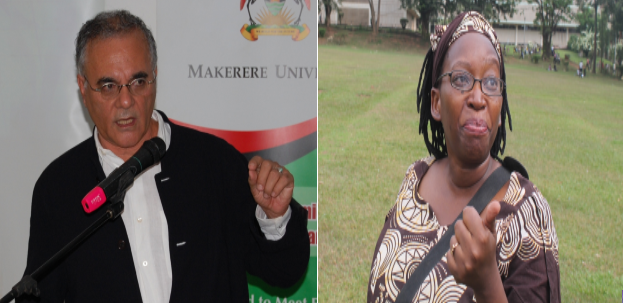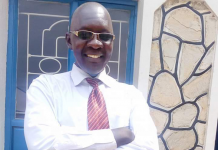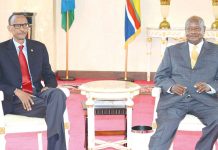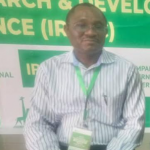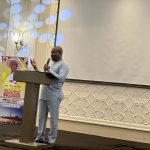At the beginning of this week, social media was stirred by images of Dr.Stella Nyanzi, a Research Fellow at Makerere Institute of Social Research (MISR) stripping in protest against the closure of her office at the institute. The strip protest was also covered on national television, through the NBS TV channel. It is likely that Nyanzi desired and indeed got widespread coverage for what she described as a “protest against injustice.”
Her actions sparked widespread debate on social media and in the public.
On one hand Dr. Nyanzi’s style of protest was understood by those who gave comment on the incident, as unusual and not befitting of her level of education, a PhD holder. She on the other hand located sympathy amongst some members of the public, who took her case to be a case of “someone fighting for her rights.”
Having been a social media champion of the opposition cause during the period running up to recently held general elections in Uganda, Nyanzi was also quickly defended by some observers of the incident without much scrutiny.
Eventually the spectacle earned her a suspension by the university’s appointments board.
The incident all started when Dr. Nyanzi came to work and found her office locked with chains and padlocks. It is possible, perhaps because she had been forewarned about the consequences by Mamdani, that she had caught wind of this much earlier for she was able to bring television reporters to the scene at the speed of light. The vice chancellor also promptly appeared on the scene, a development which also raised eyebrows.
Nyanzi blamed MISR Executive Director Professor Mahmood Mamdani for locking her out of office, because she refused to teach. To rationalize her resistance to teaching, she also suggested that it was an illegal amendment of her contractual responsibility from research to teaching.
Mamdani acknowledged this version and offered a lengthy background that in summary showed that Nyanzi could have been dishonest in giving her version of the circumstances while at the same time was insubordinate.
Nevertheless, the incident and the developments that followed her strip protest uncovered large scale tensions between Mamdani and Nyanzi, within MISR, and within the university administration that simmered up to boiling point this week.
Most times, clashes of this kind are a culmination of other issues that build up to a physical confrontation. As such when these incidents occur, it is good judgment to step back and explore the other issues that give them a context. To engage with those issues makes it possible to find a lasting solution to the problems that could have led to the actual physical confrontation.
Interpretations
There is no doubt that Mamdani is a cult figure among academia and sections of the public worldwide and in Uganda. His cult status should not blur the interpretation of where he could be right or where he could be wrong. The incident and its events if also not properly analyzed beyond a mere clash between two individuals can be interpreted in two ways.
The first is that Professor Mahmood Mamdani is probably a thorough academic but also a poor manager, an autocrat who has overseen MISR with an iron hand, making its staff and students uncomfortable. The second is that Dr.Stella Nyanzi is probably a weird and uncouth character who had demonstrated her eccentricities on social media posts anyway before this incident.
Vice Chancellor Professor Ddumba Sentamu (who in turn has been accused by Mamdani of complicity in the incident), in his wisdom, found it necessary to carry out a widespread investigation into MISR and this particular incident. The move was flatly resisted by Mamdani. A letter written by respected law Professor Oloka Onyango also poured water on the committee before it could start its work, citing possibility of bias against Mamdani.
In a lengthy memo, Mamdani rejects Ddumba’s plan to investigate and claims that the vice chancellor is part of a larger plot to dismantle the lucrative PhD program, which he (Mamdani) instituted at MISR. He falls short of explaining why Ddumba could have such a design.
It is obvious that politics and conflict (which are at the gist of this crisis) are part and parcel of organizations and organizational culture including at academic institutions like Makerere University. How they become managed is what can lead to or can prevent institutional collapse.
The preliminary questions
Makerere should count this incident as a blessing in disguise. It has presented a great research opportunity designed as a case study on organizational conflict and which should assist the university to evolve in many ways. It is evident that other sections of the university often get visited by such hot conflicts within staff.
In times of institutional or interpersonal conflict the initial viewpoints tend to focus on who could be wrong or right. When the situation cools down, the underlying issues then become explored. So most of the discussions at the beginning were about who of the two, Mamdani and Nyanzi was right or wrong, a discussion that does not resolve the issue. It is time to move beyond and look at the broader issues.
Some of the questions that we need to ask and search for answers for and which could help clear the fog around the incident are:
Why would Ddumba intend to dismantle the lucrative PhD program, which according to sources at MISR has led the institution to bring UShs 25 billion to the university up from UShs 5 billion before Mamdani started it?
What is the relationship between this incident and the undeniable fact that Mamdani’s contract has come to an end and by law he is supposed to exit?
Was this incident and its context an indication that Makerere has good academics but may have ‘poor’ managers and therefore the university needs to subject members of its staff who become managers, to occasional management workshops, to ensure the smooth running of the university and its sub-units?
Tenure at Makerere
Perhaps the biggest picture to reflect upon as the saga continues to unfold is that contract between Professor Mahmood Mamdani and Makerere University and its implications on tenure at the university. In one interview with a local newspaper, Mamdani discloses that the vice chancellor does not seem committed to giving him another five year term, yet the PhD program which he instituted needs his support to grow from the previous ten years of work.
Legally at the age of 70, Mamdani has clocked retirement age at the university. The university can however extend his stay in a special kind of arrangement, usually in short term phases.
Suffice to note, Mamdani is an active teacher, supervisor, researcher and the most prominent academic on the PhD program at MISR, which will make his exit even more complicated.
It is for this reason that a group of forty world renowned scholars could have penned a letter to the vice chancellor urging him to renew Professor Mamdani’s contract. Their letter ratified Mamdani’s further claims that the Nyanzi incident was stage managed to coincide with the uncertainty on his tenure at the university, which depending on the findings of the two investigative committees, could be terminated.
The matter is now in the hands of the Appointments Board of the university, an arbitrator which Mamdani appears to have confidence in.
In a statement issued on Friday, the board not only suspended Nyanzi but also named a four member committee to investigate issues at MISR. As if to make the process free of bias, two members of the committee come from outside the university.
The committee chair Hajjati Sharifah Buzeki, is Assistant Commissioner, Human Resource Policies and Procedure in the Ministry of Public Service. Jude Mbabaali, the other member, is a lawyer and a member of the Uganda Law Society (ULS).
Nyanzi has since threatened to strip again “if Mamdani is not equally suspended.”
The follow up questions
If we answer the preliminary questions, the follow up questions that need to be asked are,
Will this incident and the findings of the two committees, one on investigation and one on inquiry cause a restructuring of MISR to accommodate Mamdani regardless of the contract expiration?
Does this incident open debate into the need for tenure without age limit at Makerere University?
What management restructuring does Makerere need to make to improve efficiency as a public institution?
Professor Mahmood Mamdani has put forth an argument that unlike athletes or other professions whose practitioners do not develop with age, scholars accumulate more knowledge as they grow and it is unrealistic to subject them to age limits like it is in the field of sport. He gives the example of his tenure at Columbia University which he says has no age limit and wonders why this cannot be done at Makerere.
Indeed there have been many professors who upon retirement from Makerere have found lucrative employment in the numerous private universities around, raising questions as to whether they would still not serve Makerere University in the public interest, if only the law was not cast in stone.
Considering that Professor Mahmood Mamdani has raised this kind of money in donor funding, by being associated with the PhD project at MISR, and the directorship of the institute in general, is it likely that if he found his way into a private university, this funding could go along with him?
While Mamdani was initially opposed to a committee appointed to investigate the issues at MISR, it is also likely the committee could make key recommendations that could lead to the removal of age limits for the tenure of professors (or at least distinguished professors) at the university, in the process salvaging his contract and the contracts of many aging professors who are on the brink of leaving the university.
Management lessons from the clash
The Mamdani-Nyanzi row also has several management mistakes embedded and therefore lessons for the university beyond a resolution of conflict between the two individuals involved.
Something that can be easy to see is the breakdown of communication which signals the cause of the other issue, the lack of team cohesion. Mamdani and the vice chancellor do not appear to be on good terms. Yet a good relationship between the two would yield rewards for the university.
Although not much has been heard from Professor Ddumba about the saga, Mamdani on his part has said it all. It is unusual that Mamdani at his level of experience and exposure would make flimsy accusations against the vice chancellor for the sake of making them if there were no underlying realities
Ddumba has also briefly argued that “although Nyanzi acted irresponsibly, it is also true that there are issues at MISR.” He did not elaborate.
To further indicate the communication problems within, it is further surprising that Professor Mahmood Mamdani says that he asked the vice chancellor about his contract renewal at the Okot P’Bitek Symposium. Certainly a symposium is not the right channel to ask for a contract renewal. The vice chancellor should have called Mamdani to his office to discuss his contract that was due to expire. If this was not done, Mamdani would then have gone to the vice chancellor or write to the vice chancellor to inquire about the way forward.
As a sign of communication breakdown, the two main actors in the saga took to the media to address their problems. It means that internally they did not have confidence in the structures of communication, or any of the possible arbitrators in such a conflict for things had gone out of hand. This in turn cost the university in terms of image and there will have to be some resources allocated to promoting any reconciliation efforts and outcomes as a redress to the damage of MISR and Makerere’s image caused by this incident.
Rather than close Nyanzi’s office, an act that amounted to an eviction, which is ordinarily beyond his mandate, Mamdani should have handled this differently to avoid being seen as heavy handed. It is known that the deputy vice chancellor requested him to stay the eviction a request he rejected.
It would have been better for Mamdani to leave the actual process of eviction of Nyanzi to the appointments board which he had rightfully contacted over the matter for close to two years. They at an appropriate time could have instructed security, to cause such eviction.
Furthermore, the fact that the matter had dragged on for at least two years shows a sign of inefficiency, indecision and procrastination on the part of the university, which should have made a decision on Nyanzi for her refusal to take up teaching responsibilities. Mamdani says the university “tends to divert attention on many occasions,” something that needs to be addressed.
Accusations of conflict of interest have been traded by both parties in the conflict. While Mamdani accuses Ddumba of favoring Nyanzi because she is his niece, Nyanzi has equally accused Mamdani of giving office space to his wife Mira Nair, who is not a staff at MISR. Mamdani has since explained that his wife’s organization Maisha Cultural Centre rented the premises for a short period of time and the students at MISR were able to access their scholarly resources. This does not wholly wipe away a conflict of interest.
The way forward
Good management focuses on addressing behavioral problems than castigating personalities. In most cases, because behavior is adopted, personalities tend to be given a second or many more chances to reform and abandon unacceptable behavior. The aftermath of the incident, where she has promised to strip again portrays that Dr. Stella Nyanzi may not be about to reform. It would then be a good measure to discontinue her from teaching or researching in MISR an institution which she has undermined through the image problems that she has created. It may be a good decision to relocate her to another unit in the university if the university administration intends or decides to keep her.
Nyanzi has demonstrated signs of being a difficult employee, who is bent of having it her way most of the time. It is possible that this occurs in other departments as well. It is true that academic freedom and autonomy should be encouraged. But regardless of ones academic qualification, this conduct which destroys organizational cohesion should not be encouraged by any type of management regime either at unit level or at the level of the top organs of the university. Her suspension for the specific incident of stripping yet she works for an institution whose staff should be role models to students, was a penalty that was appropriate.
Because mistakes made by management in this saga are quite evident, the committee making an inquiry into the incident and MISR should propose that academics who assume management positions (including that of vice chancellor) at the university should be exposed to more regular and supportive management refresher courses or workshops so that they can cope with rapidly changing management conditions. This does not mean that they are naturally incompetent, it means just like Mamdani says, “we learn as we grow.”
A similar proposal was made a few years ago when it came to light that many lecturers were not well versed with teaching methods although they were well versed with the subjects they taught. It was proposed that all lecturers would be given basic teaching methods training by the school of education. It is not clear whether this proposal was adopted.
The writer is a Public Intellectual, Consultant and Assistant Professor of Media and Communications








